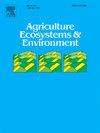Optimizing phosphate application to improve soil quality and reduce phosphorus loss in rice-wheat rotation
IF 6
1区 农林科学
Q1 AGRICULTURE, MULTIDISCIPLINARY
引用次数: 0
Abstract
How to determine the optimal dosage of phosphorus (P) fertilizer input for an agricultural field is important to maintain soil quality and crop production while minimizing environmental impact. In this study, we set up a 5-year rice-wheat rotation with contrasting P fertilization treatments (0, 25, 50, 75, 100, and 150 kg P2O5 ha−1, hereafter, P0, P25, P50, P75, P100, and P150, respectively) per season to explore the relationship between the amount of P input and crop yield, P use efficiency (PUE), balance of P accumulation and loss, ecosystem multifunctionality (EMF), and soil quality. Our results indicate that increased P amounts significantly boosted rice and wheat production of both straw and grain, but the tendency slowed down when the input was over 75 kg P2O5 ha−1. The PUE declined with increased P input and soil P balance of 50 kg P2O5 ha−1 for wheat and 100 kg P2O5 ha−1 for rice. Runoff emerges as the main pathway for soil P loss and escalates with higher P application rates. We emphasize increasing ridge height and controlling water input for basal fertilizer to minimize P loss. The application of P fertilizer increased the soil P pool, with labile P (L-P) and moderately labile P (M-P) increasing by 13–114 % and 23–111 %, respectively, compared to P0. The transformation of M-P to L-P in paddy soil is associated with an increased abundance of Actinobacteria. Low P applications (P25 and P50) increased EMF by 3.27 and 3.58 times, while high P applications (P75, P100, and P150) decreased EMF. Furthermore, P application significantly improved the soil quality index (SQI) compared to P0. The impact of abiotic factors on yield and P loss is more significant than that of biotic elements, with the SQI serving as a dependable indicator for predicting yield. Central to minimizing P loss while maximizing yield is the reduction of Resin-P content and the maintenance of NaOH-Pi levels, suggesting that organic materials may be a good alternative strategy. These findings provide valuable data and theoretical support for optimizing P application in rice-wheat cropping systems, promoting a mutually beneficial scenario for agricultural production and ecological protection.
优化磷肥施用,改善土壤质量,减少水稻-小麦轮作中的磷流失
如何确定农田磷肥的最佳施用量,对于保持土壤质量和作物产量,同时最大限度地减少对环境的影响非常重要。在本研究中,我们设置了一个为期 5 年的稻麦轮作期,每季施用不同的磷肥处理(分别为 0、25、50、75、100 和 150 kg P2O5 ha-1,以下简称 P0、P25、P50、P75、P100 和 P150),以探讨磷肥施用量与作物产量、磷肥利用效率(PUE)、磷肥积累和流失平衡、生态系统多功能性(EMF)和土壤质量之间的关系。我们的研究结果表明,增加钾的用量能显著提高水稻和小麦的秸秆和谷物产量,但当钾的投入量超过 75 kg P2O5 ha-1 时,这一趋势就会放缓。小麦的 PUE 随 P 投入量的增加而下降,土壤 P 平衡为 50 kg P2O5 ha-1,水稻为 100 kg P2O5 ha-1。径流是土壤钾流失的主要途径,并且随着钾施用量的增加而增加。我们强调增加田埂高度和控制基肥的进水量,以尽量减少钾的流失。施用钾肥增加了土壤钾库,与钾肥施用量为 0 时相比,可溶性钾(L-P)和中度可溶性钾(M-P)分别增加了 13-114 % 和 23-111 %。稻田土壤中 M-P 向 L-P 的转化与放线菌数量的增加有关。施用低浓度磷(P25 和 P50)会使 EMF 增加 3.27 倍和 3.58 倍,而施用高浓度磷(P75、P100 和 P150)会使 EMF 减少。此外,与 P0 相比,施用 P 能明显改善土壤质量指数(SQI)。非生物因素对产量和钾流失的影响比生物因素更为显著,而 SQI 则是预测产量的可靠指标。在最大限度地提高产量的同时最大限度地减少钾损失的关键是降低树脂-钾含量和保持 NaOH-钾水平,这表明有机材料可能是一种很好的替代策略。这些发现为优化水稻-小麦种植系统中的钾施用提供了宝贵的数据和理论支持,促进了农业生产和生态保护的互利共赢。
本文章由计算机程序翻译,如有差异,请以英文原文为准。
求助全文
约1分钟内获得全文
求助全文
来源期刊

Agriculture, Ecosystems & Environment
环境科学-环境科学
CiteScore
11.70
自引率
9.10%
发文量
392
审稿时长
26 days
期刊介绍:
Agriculture, Ecosystems and Environment publishes scientific articles dealing with the interface between agroecosystems and the natural environment, specifically how agriculture influences the environment and how changes in that environment impact agroecosystems. Preference is given to papers from experimental and observational research at the field, system or landscape level, from studies that enhance our understanding of processes using data-based biophysical modelling, and papers that bridge scientific disciplines and integrate knowledge. All papers should be placed in an international or wide comparative context.
 求助内容:
求助内容: 应助结果提醒方式:
应助结果提醒方式:


